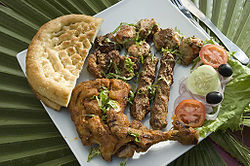This article has multiple issues. Please help improve it or discuss these issues on the talk page . (Learn how and when to remove these messages)
|
 | |
| Alternative names | Paneer rajwadi, chhena rajwadi |
|---|---|
| Type | Gravy |
| Place of origin | Indian subcontinent |
| Main ingredients | Paneer, cream, tomatoes, spices |
Shahi paneer, also known as paneer rajwadi, [1] chhena rajwadi, or raajsi chhena, is a preparation of chhena or paneer, native to the Indian subcontinent, consisting of a thick gravy of cream, tomatoes and Indian spices.
The dish is prepared by emulsifying tomatoes, onions, ground cashews, ghee (clarified butter), and cream into a smooth, rich curry, which is then simmered with cubes of chhena or paneer and a blend of aromatic spices.
Similar dishes include paneer butter masala and kadai paneer. The subtle difference between paneer butter masala and shahi paneer is that more of whole spices are used in paneer butter masala, whereas shahi paneer has a generally sweeter taste when compared to paneer butter masala. [2]
